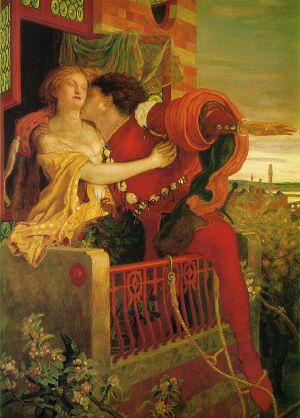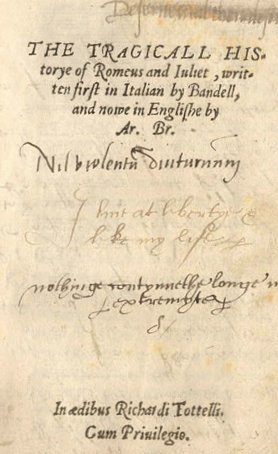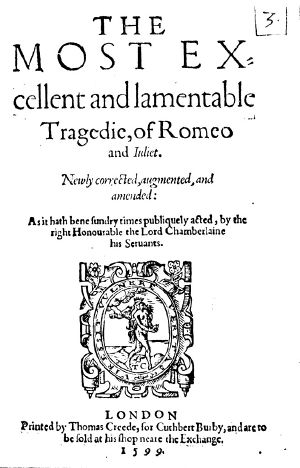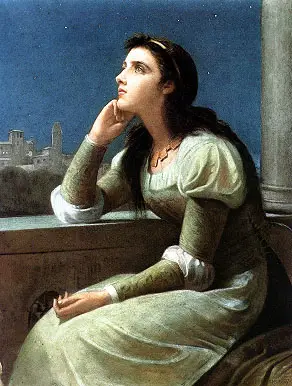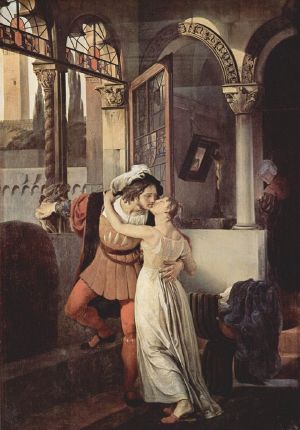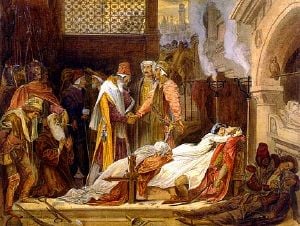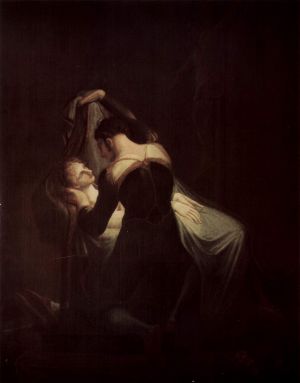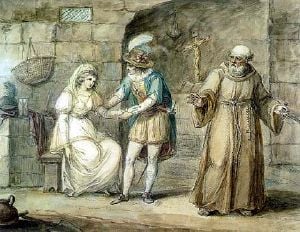Romeo and Juliet
Romeo and Juliet is a world-renowned tragedy by William Shakespeare concerning two young "star-cross'd lovers" and the role played by their tragic suicides in ending a long-running family feud. It is one of the most famous of Shakespeare's plays, one of his earliest theatrical triumphs, and is thought to be the most archetypal love story of the Renaissance and indeed in the history of Western culture.
Although Romeo and Juliet belongs to a tradition of tragic romances stretching back at least as far as the Ancient Greeks, it is based on an Italian tale, the earliest known version dating to 1476. In 1562, Arthur Brooke translated one of the Italian tales into English, which was then retold in prose by William Painter. Brooke's poem and Painter's short story are considered to be Shakespeare's sources for Romeo and Juliet. Shakespeare borrowed heavily from both, but developed their minor characters, such as Mercutio and Count Paris, in order to expand the plot. Although it is unknown exactly when the play was written, most scholars agree on 1595-1596. The first know publication of the play was in Shakespeare's First Quarto, published in 1597. Later editions, such as the Second Quarto corrected the first version to make it more in line with Shakespeare's original text.
Scholarly analysis of the play has praised the play in many areas: Shakespeare's use of dramatic structure, especially his expansion of minor characters and use of subplots to embellish the story. With language, Shakespeare ascribes different poetic skills to different characters as they develop. Romeo, for example, grows more adept in the sonnet form as they play continues. No overarching theme for the play has been agreed upon by scholars. Still, analysis frequently focuses on a few non-encompassing themes, such as the nature of romantic and familial love and the role of fate versus the consequences of human actions. While the play is popularly seen as the quintessential story of romantic love, it is an ironic example since the lovers both commit suicide.
Romeo and Juliet has been adapted several times.
Sources
Romeo and Juliet is a dramatization of Arthur Brooke's narrative poem The Tragical History of Romeus and Juliet (1562). Shakespeare followed Brooke's poem closely[1] but enriched its texture by adding extra detail to both major and minor characters, in particular the Nurse and Mercutio. Shakespeare also knew "The goodly History of the true and constant love of Rhomeo and Julietta", a prose retelling of the story by William Painter, published in a compilation of Italian tales entitled Palace of Pleasure (1582).[2] Painter's version was part of a common theme among writers and playwrights in publishing works based on Italian novelles. At the time of Shakespeare's Romeo and Juliet, Italian tales were very popular among theater-goers. Gibbons believes that Shakespeare took advantage of this, as evidenced by his writing of All's Well That Ends Well and Measure for Measure along with Romeo and Juliet. Critics of the day even complained about how often such Italian tales were borrowed to please the crowds. The stories were so popular that the tale of Romeo and Juliet had been played on stage before Shakespeare wrote his version of it.[3]
In keeping with this tradition of borrowing from Italy, Arthur Brooke's poem was actually a translation and adaptation of the Italian Giuletta e Romeo, by Matteo Bandello, included in his Novelle of 1554.[4] Bandello's story was the most famous and was translated into French (and into English by Brooke). It was also adapted by Italian theatrical troupes, some of whom performed in London at the time that Shakespeare was writing his plays. Although nothing is known of the repertory of these itinerant troupes, it is possible that they performed a version of the story.[5]
Bandello's version was in turn an adaptation of Luigi da Porto's Giulietta e Romeo, included in his Istoria novellamente ritrovata di due Nobili Amanti (c. 1530).[4]Da Porto's version gave the story much of its modern form, including the names of the lovers, the rival families of Montecchi and Capuleti, and the location in Verona, in the Veneto.[6] : Their tragic story seems to have connections with Shakespeare's Romeo and Juliet.]] Da Porto also is probably the source of the traditions that Romeo and Juliet is based on a true story.[7] The names of the families (in Italian, the Montecchi and Capelletti) were actual political factions of the thirteenth century.[8] To this day the tomb and a balcony representing that of Guilietta are a popular tourist spot in Verona, although scholars have disputed all claims that the story really occurred.[7] Before Da Porto, the earliest known version of the tale is the 1476 story of Mariotto and Gianozza of Siena by Masuccio Salernitano, in Il Novellino (Novella XXXIII).[6]
Further back, Romeo and Juliet borrows from a tradition of tragic love stories going back at least as far as the Ancient Greeks. The story of Pyramus and Thisbe, for example, is thought by many scholars to have influenced da Porto's version of the story. This tale contains parallels in the hatred of the two lovers' parents for each other, as well as Pyramus' falsely believing his mistress Thisbe is dead.[9] Geoffrey Chaucer's Troilus and Criseyde also had an effect on Arthur Brooke's Romeus and Juliet, with Brooke adjusting the Italian translation to reflect parts of this English classic. The Ephisiaca of Xenophon of Ephesus, written in the third century, also contains several similarities to the play, such as a separation of lovers, and a potion which causes a deathlike sleep. Christopher Marlowe's Hero and Leander and Dido, Queen of Carthage are similar stories written much closer to Shakespeare's day, but are thought to be less of a direct influence, although they may have helped to create an atmosphere in which tragic love stories could thrive.[10]
Date and text
The exact date in which Shakespeare wrote Romeo and Juliet is unknown. Scholars estimate that it may have been written in 1595 or 1596, though some argue for the year 1591. Juliet's nurse refers to an earthquake which occurred 11 years prior to the action in the play. An earthquake had occurred in England in 1580, which could mean the play originally came from 1591. However, the play's stylistic similarities with A Midsummer Night's Dream, as well as evidence of performances at the time (the play was becoming popular at around 1595), place the play in 1595 or 1596. The compromise consensus is that he may have begun a draft in 1591, which he completed in 1595-1596.[11][12]
Shakespeare's Romeo and Juliet was published in two distinct quarto editions prior to the publication of the First Folio of 1623. These are referred to as Q1 and Q2. Q1, the first printed edition, appeared in 1597, printed by John Danter. Because its text contains numerous differences from the later editions, it is labeled a 'bad quarto': the twentieth century editor T. J .B. Spencer described it as "a detestable text, probably a reconstruction of the play from the imperfect memories of one or two of the actors."[13] Q1 indicates that, along with many other playwrights of the time, Shakespeare's plays were probably heavily edited before performances by playing companies, and Romeo and Juliet is no exception.[14]
The superior Q2 called the play The Most Excellent and Lamentable Tragedie of Romeo and Juliet. It was printed in 1599, published by Cuthbert Burby and printed by Thomas Creede. Q2 is about 800 lines longer than Q1.[14] Its title page describes it as "Newly corrected, augmented and amended." Scholars believe that this text was based on Shakespeare's pre-performance draft, (called his foul papers), since there are textual oddities such as variable tags for characters and "false starts" for speeches that were presumably struck through by the author but erroneously preserved by the typesetter. It is a much more complete and reliable text, and was reprinted in 1609 (Q3), 1622 (Q4) and 1637 (Q5).[13] In fact, all later Quartos and Folios of Romeo and Juliet are based on Q2, offering little additional information on Shakespeare's original work.[15]
The First Folio text of 1623 seems to be based primarily on Q3, with clarifications and corrections possibly coming from a theatrical promptbook or Q1.[13][16] Other Folio editions of the play were printed in 1632 (F2), 1664 (F3), and 1685 (F4).[17] Modern versions considering several of the Folios and Quartos began printing with Nicholas Rowe's 1709 edition, followed by Alexander Pope's 1723 version. Pope began a tradition of editing the play to add information such as stage directions missing in Q2 by locating them in Q1. This tradition continued late into the Romantic period. Fully annotated editions began printing in the Victorian period and continue to this day, printing the text of the play with footnotes describing the sources and culture behind the play.[18]
Characters
Ruling house of Verona
- Prince Escalus: Prince of Verona
- Count Paris: Kinsman of Prince Escalus; desires to marry Juliet.
- Mercutio: Another kinsman of Prince Escalus; a friend of Romeo.
Capulets
- Lord Capulet: Patriarch of the house of Capulet.
- Lady Capulet: Matriarch of the house of Capulet; wishes Juliet to marry Paris.
- Juliet: Daughter of the Capulets; the female protagonist.
- Tybalt: Cousin of Juliet, nephew of Lady Capulet.
Capulet Servants
- Nurse: Juliet's personal attendant and confidante: a comic figure who took care of little Juliet ever since she was an infant.
- Peter: Capulet servant, assistant to the nurse, illiterate
- Sampson: Capulet servant.
- Gregory: Capulet servant.
Montagues
- Lord Montague: Patriach of the house of Montague.
- Lady Montague: Matriarch of the house of Montague
- Romeo: Son of the Montagues; the male protagonist.
- Benvolio: Cousin and friend of Romeo.
Montague Servants
- Abraham: Montague servant.
- Balthasar: Romeo's personal servant.
Others
- Friar Lawrence: a Franciscan friar and Romeo's confidant.
- Chorus, who gives the opening prologue and one other speech, both in the form of a Shakespearean sonnet.
- Rosaline, an unseen character with whom Romeo briefly falls in love with before meeting Juliet.
- Friar John: Another friar who is sent to deliver Friar Lawrence's letter to Romeo.
- Apothecary: Druggist who reluctantly sells Romeo poison.
Synopsis
"Two Households, both alike in dignity …"
Chorus
The play begins with a street-battle between two families, the Montagues and the Capulets. The Prince of Verona, Escalus, intervenes with his men and declares that the heads of the two families will be held personally accountable for any further breach of the peace.
Later, Count Paris, a young nobleman, talks to Lord Capulet about marrying his thirteen-year-old daughter, Juliet. Capulet demurs, citing the girl's tender age, and invites him to attract the attention of Juliet during a ball that the family is to hold that night. Meanwhile, Juliet's mother tries to persuade her daughter to accept Paris' wooing during their coming ball. Juliet states that she will make an effort to love him, but will not go after what is not there. In this scene Juliet's nurse is introduced as a talkative and humorous character who has raised Juliet from infancy.
Meantime, Benvolio queries his cousin Romeo, Lord Montague's son, to find out the source of his melancholy. He discovers that it stems from an unrequited love for a girl named Rosaline. Upon the insistence of Benvolio and another friend, Mercutio, Romeo decides to attend the masquerade at the Capulet house, in hope of meeting Rosaline.
Alongside his masked friends, Romeo attends the ball as planned. However, instead of Rosaline, he is smitten with his neighbor, Juliet, whom he rather oddly appears to see for the first time. She is also taken with him. (This odd fact remains unexplained.) After discovering that the lovers are of feuding blood, Romeo and Juliet meet on Juliet's balcony. Despite their families' feud, the two declare their love for each other and their intent to marry. With the help of the Franciscan Friar Lawrence, who hopes to reconcile the two families through their children's union, the two are married secretly the next day.
All seems well until Tybalt, Juliet's hot-blooded cousin, challenges Romeo to a duel for appearing in the Capulets' ball disguised. Though no one is aware of the marriage yet, Romeo refuses to fight Tybalt since they are now kinsmen. Mercutio is incensed by Tybalt's insolence, and accepts on Romeo's behalf. In the ensuing duel, Mercutio is fatally wounded when Romeo tries to intervene. Romeo, angered by his friend's death, pursues and slays Tybalt, then flees.
Despite his promise to call for the head of the wrong-doers, the Prince merely exiles Romeo from Verona, reasoning that Tybalt first killed Mercutio, and Romeo merely carried out a just punishment to Tybalt, although without legal authority. Meanwhile, the Capulets engage their unwilling daughter to marry Paris in three days' time, threatening to disown her if she does not. The Nurse, once Juliet's confidante, now tells her she should discard the exiled Romeo and comply. Juliet desperately visits Friar Lawrence for help. He offers her a drug which will put her into a death-like coma for 42 hours. She is to take it, and, when discovered apparently dead, she will be laid in the family crypt. While in her sleep, the Friar will send a messenger to inform Romeo, so that she can rejoin him when she awakes.
The messenger, however, does not reach Romeo. Romeo instead learns of Juliet's "death" from his servant, Balthasar. Grief-stricken, he buys strong poison from an apothecary, returns to Verona in secret, and visits the Capulets' crypt. He encounters Paris, who has come to mourn Juliet privately. Paris confronts Romeo, believing him to be a vandal, and in the ensuing battle, Romeo kills Paris. Romeo says his final words to the comatose Juliet and drinks the poison in suicide. Juliet then awakes. Friar Lawrence arrives and, aware of the cause of the tragedy, begs Juliet to leave, but she refuses. At the side of Romeo's dead body, she stabs herself with her lover's dagger.
The feuding families and the Prince meet at the tomb to find three youths of their families dead. In explanation, Friar Lawrence recounts the story of the two lovers. Montague reveals that his wife has died of grief after hearing of her son's exile. The families are reconciled by their children's deaths and agree to end their violent feud. The play ends with the Prince's brief elegy for the lovers. The Capulets erect a statue of Romeo and the Montagues will erect one of Juliet. The Prince makes his parting words: "For never was a story of more woe Than this of Juliet and her Romeo."
Analysis
Dramatic structure
Shakespeare shows his dramatic skill freely in Romeo and Juliet, providing intense moments of shift between comedy and tragedy, and weaving plots and subplots to paint a clearer picture of the story. Before Mercutio's death in Act three, the play is largely a youthful comedy.[19] After his accidental demise, the play suddenly becomes very serious and takes on more of a tragic tone. Still, the fact that Romeo is banished, rather than executed, offers a hope that things will work out. When Friar Laurence offers Juliet a plan to reunite her with Romeo the audience still has a reason to believe that all will end well. They are in a "breathless state of suspense" by the opening of the last scene in the tomb: If Romeo is delayed long enough for the Friar to arrive, he and Juliet may yet be saved.[20] This only makes it all the more tragic when everything falls apart in the end.[21]
Subplots offer a clearer view of the actions of the main characters, and provide an axis around which the main plot turns. For example, when the play begins, Romeo is in love with Rosaline, who has refused all of his advances. Romeo's infatuation with her stands in obvious contrast to his later love for Juliet. This provides a comparison through which the audience can see the seriousness of Romeo and Juliet's love and marriage. Paris' love for Juliet also sets up a contrast between Juliet's feelings for him and her feelings for Romeo. The formal language she uses around Paris, as well as the way she talks about him to her Nurse, show that her feelings clearly lie with Romeo. Beyond this, the sub-plot of the Montague-Capulet feud overarches the whole play, providing an atmosphere of hate that is the main contributor to the play's tragic end[21]
Language
Shakespeare uses a large variety of poetic forms throughout the play. The play begins with a 14-line prologue by a Chorus in the form of a Shakespearean sonnet. The greater part of Romeo and Juliet is written in iambic pentameter. Though the most common form is blank verse, Shakespeare uses it less often in this play than in his later plays. Shakespeare matches the forms to the characters who use them. Friar Laurence, for example, uses sermon and sententiae forms, and the Nurse uses a unique blank verse form that closely matches colloquial speech. The forms are also molded and matched to characters and to the emotion of the scene they occupy. For example, when Romeo talks about Rosaline earlier in the play, he uses the Petrarchan sonnet form. Petrarchan sonnets classically were used by men to exaggerate the beauty of women who were impossible for them to attain, much like Romeo's situation with Rosaline. This sonnet form is also used by Lady Capulet to describe Count Paris to Juliet as a handsome (though not unattainable) man. When Romeo and Juliet meet, the poetic form changes from the Petrarchan (which was becoming archaic in Shakespeare's day) to a more contemporary sonnet form, using the language of "pilgrims" and "saints." Finally, when the two meet on the balcony, Romeo attempts to use the sonnet form to pledge his love to her, but Juliet interrupts it with the straightforward question, "Dost thou love me?"[22] By doing this, she is searching for the reality, rather than the exaggeration of their love. Other forms include an epithalamium by Juliet, a rhapsody in Mercutio's Queen Mab speech, and an elegy by Paris. Shakespeare also uses a prose style, most often for the common people in the play, though at times for other characters, such as Mercutio.[23]
Themes and motifs
Scholars have found it extremely difficult to assign one specific, over-arching theme to the play. Bowling considers the main theme to be "the discovery" by the characters that human beings are neither wholly good nor wholly evil, but instead are "more or less alike".[24] Numerous other attempts have proposed that the theme is awaking out of a dream and into reality, or the danger of hasty action, or the power of tragic fate. None of these have widespread support. However, even if an overall theme cannot be found it is clear that the play is full of several small, thematic elements which intertwine in complex ways. Several of those which are most often debated by scholars are discussed below.[25]
Love
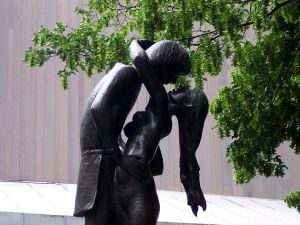
Romeo and Juliet is sometimes considered to have no unifying theme, save that of young love.[24] In fact, the characters in it have become emblems all who die young for their lovers. Several scholars have pointed out the different ways Shakespeare describes love in the play. On their first meeting, Romeo and Juliet use a form of communication recommended by many love advisers in Shakespeare's day: metaphor. By using the metaphor of saints and sins, Romeo can test Juliet's feelings for him in a non-threatening way. This method was recommended by Baldassare Castiglione (whose works had been translated into English by this time), because the woman could pretend she didn't understand the metaphor, and the man could take the hint and back away without losing his honor. Juliet, however, makes it clear that she is interested in Romeo, and plays along with his metaphor. Later, in the balcony scene, Shakespeare has Romeo overhear Juliet's declaration of love for him. In Brooke's version of the story, her declaration is done in her bedroom, alone. By bringing Romeo to eavesdrop, Shakespeare breaks from the normal sequence of courtship. Usually, a woman was required to play hard to get, in order to be sure that her suitor was sincere. His breaking the sequence, however, serves to speed along the plot. The lovers are able to skip a lengthy part of wooing, and move on to straight talk about their relationship—developing into an agreement to be married after knowing each other for only one night.[26]
While the play is often read as the epitome of romantic love, there is also a critical tone of their rashness as well running throughout the play. Their love is quite hasty, as is Romeo's willingness to throw over Rosaline for Juliet. In addition, the play arguably equates love and sex with death. Both Romeo and Juliet fantasize about death, often equating him with a lover. Capluet, when first discovering Juliet's faked death, describes Death as having deflowered his daughter. Juliet even compares Romeo to death in an erotic way. One of the strongest examples of this in the play is in Juliet's suicide, when she says, grabbing Romeo's dagger, "O happy dagger! / …This is thy sheath / there rust, and let me die." The dagger here can be a sort of phallus of Romeo, with Juliet being its sheath in death, a strong sexual symbol intertwined with death.[27]
In the Middle Ages, Love was considered to be a powerful god and force of nature with power over all humanity. In this final suicide scene, there is a contradiction in the message–in Christianity, suiciders are condemned to hell, whereas people who die to be with their loves under the "Religion of Love" are joined with their loves in paradise. Romeo and Juliet's love seems to be expressing the "Religion of Love" view rather than the Christian view. Another point is that although their love is passionate, it is only consummated in marriage, which prevents them from losing the audience's sympathy.[28]
Fate and chance
Scholars are divided on the role of fate in the play. It is a given that they make a series of stupendously bad choices, but no consensus exists on whether the characters are truly fated to die together no matter what they do, or whether these events take place by a series of unlucky chances. In one reading, Romeo and Juliet are star-crossed, they are fated never to be together. In attempting to defy this fate, they ensure it. These arguments often refer to the description of the lovers as "star-cross'd," a phrase in the play that seems to hint that the stars have determined the lovers' fates.[29] Draper points out that several parallels can be drawn between the Elizabethan belief in humors and the main characters of the play (for example, Tybalt as a choleric). Interpreting the text in the light of the Elizabethan-era science of humorism reduces the amount of the plot that is attributed to chance by a modern audience. Still, some scholars see the play as a mere series of unlucky chances to such a degree that it is not a tragedy at all, but an emotional melodrama.[30] Nevo, on the other hand, represents the camp that stresses the high degree to which chance is stressed in the narrative, making Romeo and Juliet a "lesser tragedy" of chance, not of character (hubris). Romeo's challenging of Tybalt is not impulsive, it is, after Mercutio's death, the expected course of action to take. In this scene, Nevo reads Romeo as being aware of the dangers of flouting social norms, identity and commitments. He makes the choice to kill, not because of a tragic flaw, but because of circumstance.[31]
Light and dark
"In Romeo and Juliet …the dominating image is light, every form and manifestation of it; the sun, moon, stars, fire, lightning, the flash of gunpowder, and the reflected light of beauty and of love; while by contrast we have night, darkness, clouds, rain, mist, and smoke."|Caroline Spurgeon|[32]
Scholars have long noted Shakespeare's widespread use of light and dark imagery throughout the play. The light theme was initially taken to be "symbolic of the natural beauty of young love," an idea beginning in Caroline Spurgeon's work Shakespeare's Imagery and What It Tells Us, although the perceived meaning has since its publication branched in several directions.[31][32] The play contrasts light and dark in several ways. For example, both Romeo and Juliet see the other as light in a surrounding darkness. Romeo describes Juliet as being like the sun,[33] brighter than a torch,[34] a jewel sparkling in the night,[35] and a bright angel among dark clouds.[36] Even when she lies apparently dead in the tomb, he says her "beauty makes / This vault a feasting presence full of light."[37] Juliet describes Romeo as "day in night" and "Whiter than snow upon a raven's back."[38][39] This contrast of light and dark can be expanded as contrasting love and hate, youth and age in a metaphoric way.[31] Sometimes the metaphor creates a dramatic irony. For example, Romeo and Juliet's love is a light in the midst of the darkness of the hate around them, but all of their activity together is done in night and darkness, while all of the feuding is done in broad daylight. This paradox of imagery adds to the moral dilemma facing the two lovers: loyalty to family or loyalty to love. This in turn adds significant dramatic effect and emotion to the story. At the end of the story, when the morning is gloomy and the sun hiding its face for sorrow, light and dark has been returned to its proper place, the outward darkness, reflecting the true, inner darkness of the family feud, out of sorrow for the lovers. All characters now recognize their folly in light of recent events, and things return to the natural order, thanks to the love of Romeo and Juliet.[32] The "light" theme in the play is also heavily connected to the theme of time, since light was a convenient way for Shakespeare to express the passage of time through descriptions of the sun, moon, and stars.[40]
Time
Time plays an important role in the language and plot of the play. Both Romeo and Juliet refer to their struggle to maintain an imaginary world void of time and full of love in the face of the harsh realities of unstoppable time that surround them. For instance, when Romeo attempts to swear his love to Juliet by the moon, Juliet tells him not to, as it is known to be inconstant over time, and she does not desire this of him. From the very beginning, the lovers are designated as "star-cross'd"[41] referring to an astrologic belief which is heavily connected to time. Stars were thought to control the fates of men, and as time passed, stars would move along their course in the sky, also charting the course of human lives below. Romeo speaks of a foreboding he feels in the stars movements' early in the play, and when he learns of Juliet's death, he defies the stars' course for him. When Romeo visits Juliet, spending the night in her room, they debate the next morning which bird call they hear, the nightingale or another.
The theme of "haste" can be considered as fundamental to the play.[40] Shakespeare compresses the action of Romeo and Juliet into what is generally considered to span a period of four to six days, in contrast to Brooke's poem spanning nine months. Scholars such as Tanselle believe that time was "especially important to Shakespeare" in this play, as he used references to "short-time" for the young lovers as opposed to references to "long-time" for the "older generation" to highlight "a headlong rush towards doom".[40] Romeo and Juliet repeatedly attempt to fight the effects of time in the world around them in their desire for their love to last forever. In the end, the only way they see to defeat time is through a timeless death which makes them noteworthy enough to be made immortal through art.[42]
Time is heavily connected to the theme of light and dark, as well. Shakespeare's play is said in the Prologue to be about two hours long, creating a paradox for any playwright.[42] In Shakespeare's day, plays were often performed at noon in broad daylight, requiring the playwright to create his own methods for the illusion of passing time in his plays. Shakespeare uses references to the light and dark of night and day, the stars, the moon, and the sun to create this illusion. He also has characters frequently refer to days of the week and specific hours of the day to help the audience understand that time has passed in the story. All in all, no fewer than 103 specific references to time are found in the play, adding to this illusion of its passage.[43][44]
Other approaches
Psychoanalytic
Psychoanalytic critics focus largely on Romeo's depressive state with Rosaline before he meets Juliet, as well as the function of hate in their relationship as a result of the family feud. The looming image of inevitable death is explored as well. This line of criticism argues that Shakespeare is in love with Juliet because she is to him the all-present, all-powerful mother which he needs to fill a void he feels in his own mother. The feud between the families provides a source of phallic expression for the male Capulets and Montagues This sets up a system where patriarchal order is in power. When the sons are married, rather than focusing on the wife, they are still owed an obligation to their father and family. This conflict between obligation to the father (the family name) and the wife (the feminine), determines the course of the play. Some critics argue this hatred is the sole cause of Romeo and Juliet's passion for each other. The fear of death and the knowledge of the danger of their risking a relationship is in this view channeled into a romantic passion.[45]
Feminist
Feminist critics also point out that the blame for the family feud lies in the patriarchal order of society in Verona. The strict, masculine code of violence imposed on Romeo is the main force driving the tragedy to its end. When Tybalt kills Mercutio, for example, Romeo shifts into this violent mode, regretting that Juliet has made him so "effeminate".[46] Juliet also submits to a female code of docility by allowing others, such as the Friar, to solve her problems for her. Other critics, such as Dympna Callaghan, look at the play's feminism from a more historicist angle. They take into account the fact that the play is written during a time when the patriarchal order was being challenged by several forces, most notably the rise of Puritanism, which viewed marriage and sexuality as less of a "necessary evil" than other philosophies had done. For example, when Juliet dodges her father's attempt to force her to marry Paris in an attempt to stay with the man she really has feelings for, she is successfully challenging the patriarchal order in a way that would not have been possible at an earlier time.[47]
Gender studies
Gender studies critics largely question the sexuality of two characters, Mercutio and Romeo. The argument centers around the difference between sexual love and friendship, a difference which, in this view, Shakespeare discusses heavily in the play. Mercutio's friendship with Romeo, for example, leads to several friendly conversations, including ones on the subject of Romeo's phallus. This would seem to suggest traces of homoeroticism.[48] Romeo, as well, admits traces of the same in his love for Rosaline and Juliet. Rosaline, it seems, is distant and unavailable except in the mind, bringing no hope of offspring. As Benvolio argues, she is best replaced by someone who will reciprocate. Shakespeare's procreation sonnets describe another young man who, like Romeo, is having trouble finding such a person, and who (possibly also like Romeo) is homosexual. In this view, when Juliet says "…that which we call a rose / By any other name would smell as sweet",[49] she may be raising the question of whether there is any difference between the beauty of a man and the beauty of a woman.[50]
Performances and adaptations
Stage history
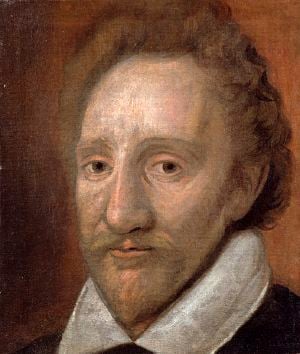
Romeo and Juliet was a popular play in Shakespeare's lifetime. Gary Taylor measures it as the sixth most popular of Shakespeare's plays, in the period after the death of Marlowe and Kyd but before the ascendancy of Jonson during which Shakespeare was London's dominant playwright.[52] The exact date of the first performance of Shakespeare's Romeo and Juliet, however, is unknown. The First Quarto, printed in 1597, says that "it hath been often (and with great applause) plaid publiquely," setting the first performance prior to that date. The Lord Chamberlain's Men were certainly the first to perform it. Besides their strong connections with Shakespeare, the Second Quarto actually names one of its actors, Will Kemp, instead of Peter in a line in Act five. Thus, Richard Burbage was probably the first Romeo, being the company's leading actor, and Master Robert Goffe (a male) the first Juliet.[53]
After the theatres re-opened in the Restoration, Sir William Davenant staged a 1662 production in which Henry Harris played Romeo, Thomas Betterton was Mercutio, and Betterton's wife Mary Saunderson played Juliet.[54] (Mrs. Saunderson was probably the first female to play Juliet professionally.[55]) This play was criticized by Samuel Pepys as the worst he had ever heard. Versions immediately following this were changed to tragicomedies, where the two lovers did not die in the end.[56] Thomas Otway's adaptation The History and Fall of Caius Marius, one of the more extreme of the Restoration versions of Shakespeare, debuted in 1680. The scene is shifted from Renaissance Verona to ancient Rome; Romeo is Marius, Juliet is Lavinia, the feud is between patricians and plebians; Juliet/Lavina wakes from her potion before Romeo/Marius dies. Otway's version was a hit, and was acted for the next 70 years. It altered the sexual language of the play as well, toning down the Queen Mab speech, for example.[57] Theophilus Cibber mounted his own adaptation in 1744, followed by David Garrick's in 1748. Both Cibber and Garrick used variations on Otway's innovation in the tomb scene.[58] These versions also eliminated elements deemed inappropriate for the time. For example, Garrick's version transferred all language describing Rosaline to Juliet, in order to heighten the idea of faithfulness and downplay the love-at-first-sight theme.[59][60] In 1750 a "Battle of the Romeos" began, with Spranger Barry and Susannah Maria Arne (Mrs. Theophilus Cibber) at Covent Garden versus David Garrick and George Anne Bellamy at Drury Lane.[61]
Garrick's altered version of the play was very popular, and ran for nearly a century.[62] Not until 1845 did Shakespeare's original returned to the stage in the United States (with the sisters Charlotte and Susan Cushman as Romeo and Juliet),[63][64] and in 1847 in Britain (Samuel Phelps at Sadler's Wells).[65] Saunders actively reverted Garrick's additions and changes to the original, and adhered to Shakespeare's version, beginning a string of eighty-four performances. Her portrayal of Romeo was considered genius by many, as she called more attention to Romeo's character than other's, making the play largely his tragedy. Cushman's success broke the Garrick tradition and paved the way for later plays.[66] Henry Irving's 1882 production at the Lyceum Theatre is considered an archetype of his "pictorial" style, placing the action on elaborate sets. Irving himself played Romeo, and Ellen Terry played Juliet.[67] In 1895, actor Forbes-Robertson took over for Irving, and laid the groundwork for a more natural portrayal of Shakespeare that remains popular today. Forbes-Robertson avoided the showiness of Irving and instead portrayed a down-to-earth Romeo, expressing the poetic dialogue as realistic prose and avoiding melodramatic flourish. Meanwhile, American theaters began performing the play, eventually rivaling their British counterparts with the likes of Edwin Thomas Booth (brother to John Wilkes Booth) and Mary McVicker as Romeo and Juliet. The play found popularity throughout continental Europe, as well.[68]
In one of the most notable twentieth century performances, staged by John Gielgud at the New Theatre in 1935, Gielgud and Laurence Olivier played the roles of Romeo and Mercutio, exchanging roles six weeks into the run, with Peggy Ashcroft as Juliet.[69]
Other notable twentieth century productions include Guthrie McClintic's 1934 Broadway staging in which Katharine Cornell had a triumph as Juliet opposite Basil Rathbone as Romeo and Edith Evans (who also played the role in the Gielgud production) as the Nurse. Cornell later revived the production with Maurice Evans as Romeo and Ralph Richardson as Mercutio, both making their Broadway debuts. Franco Zeffirelli mounted a legendary staging for the Old Vic in 1960 with John Stride and Judi Dench that served as the basis for his 1968 film.[70]
Stage adaptations
When Romeo and Juliet is adapted for the stage, it is sometimes set in a modern or well-known historical setting, enabling audiences to understand, and perhaps to reflect upon, the underlying conflicts. For example, adaptations have been set in the midst of the Israeli-Palestinian conflict,[71] in the apartheid era in South Africa,[72] and in the aftermath of the Pueblo Revolt.[73] Among the most famous of such adaptations is Peter Ustinov's 1956 comic adaptation, Romanoff and Juliet, set in a fictional mid-European country in the depths of the Cold War.[74]
Music
At least 24 operas and plays have been based on Romeo and Juliet, the best known being Gounod's Roméo et Juliette (1867) and Bellini's opera I Capuleti e i Montecchi.[75] The libretto in Gounod's play was by Jules Barbier and Michel Carré.[76] Bellini's opera has rarely been judged favorably, in part because of its perceived liberties with Shakespeare; however, Bellini and his librettist, Felice Romani, worked from Italian sources, with no intention to adapt Shakespeare's play.[77] In 2004 American composer Lee Hoiby also adapted Romeo and Juliet to write an opera of the same name.[78]
Since the eighteenth century, several ballet versions have been composed; among the better-known is Prokofiev's Romeo and Juliet, first performed in 1938.[79]
Roméo et Juliette by Berlioz is a "symphonie dramatique," a large scale work in three parts for mixed voices, chorus and orchestra, premiered in 1839.[80] The Romeo and Juliet Fantasy Overture (1869, revised 1870 and 1880), by Tchaikovsky is a long symphonic poem, containing the famous melody known as the "love theme".[81]
The play led to a number of musical theatre adaptations, the most famous of which was West Side Story with music by Leonard Bernstein and lyrics by Stephen Sondheim. It debuted on Broadway in 1957 and in London's West End in 1958, and became a popular film in 1961. This version updated the setting to mid-twentieth century New York City, and the warring families to ethnic gangs.[82] Other musical adaptations include Terrence Mann's 1999 rock musical William Shakespeare's Romeo and Juliet, co-written with Jerome Korman,[83] Gérard Presgurvic's 2001 Roméo et Juliette, de la Haine à l'Amour and Riccardo Cocciante's 2007 Giulietta & Romeo.[84]
Screen
In putting Romeo and Juliet on screen, the director must set the action in a social context that illuminates the characters, and mediates between the Renaissance play and modern audiences.[85] George Cukor, in 1970, commented on why his "stately" and "stodgy" 1936 film had not stood the test of time, saying that if he had the opportunity to make it again he would "get the garlic and the Mediterranean into it".[86] Yet that performance (featuring Norma Shearer and Leslie Howard, with a combined age over 75, as the teenage lovers) had garnered no fewer than four Oscar nominations.[87]
The films' openings highlight each director's care to establish authenticity: Cukor introduces his characters in a shot of a scene played on a proscenium stage; Renato Castellani's 1954 version opens with John Gielgud, famous as a stage Romeo, as the Prologue in Elizabethan doublet and hose; Zeffirelli sets his scene with an overview of Verona, and his Prologue, in voiceover, was another famous stage Romeo: Laurence Olivier. In contrast, Romeo + Juliet in 1996 was targeted at a young audience, and opens with images of television and print journalism.[88]
A particular difficulty for the screen-writer arises towards the end of the fourth act, where Shakespeare's play requires considerable compression to be effective on the big screen, without giving the impression of "cutting to the chase".[89] In Franco Zeffirelli's 1968 version, Juliet's return home from the Friar's cell, her submission to her father and the preparation for the wedding are drastically abbreviated, and similarly the tomb scene is cut short: Paris does not appear at all, and Benvolio (in the Balthazar role) is sent away but is not threatened.[90] In Baz Luhrmann's Romeo + Juliet, the screenplay allows Juliet to witness Romeo's death, and the role of the watch is cut, permitting Friar Lawrence to remain with Juliet and to be taken by surprise by her sudden suicide.[91]
Including the four major theatrical releases already mentioned, Shakespeare's play has been filmed numerous times.[92] Several of the adaptations of the story have also been filmed, most notably West Side Story, Prokofiev's ballet and Romanoff and Juliet. Also, several theatrical films, such as Shakespeare in Love and Romeo Must Die, consciously use elements of Shakespeare's plot.
Notes
- ↑ Arthur J. Roberts, "The Sources of Romeo and Juliet." Modern Language Notes 17(2) (Feb 1902): 41-44.
- ↑ N. H. Keeble. York Notes on Romeo and Juliet. (Longman, 1980), 18
- ↑ Brian Gibbons. Romeo and Juliet. (London: Methuen, 1980. ISBN 0416178502), 32-33.
- ↑ 4.0 4.1 Olin Moore, "Bandello and Clizia." Modern Language Notes 52 (1937): 38-44.
- ↑ Madeleine Doran. Endeavors of Art. (Madison: University of Wisconsin Press, 1954), 132.
- ↑ 6.0 6.1 Richard Hosley, (ed.) Romeo and Juliet. (New Haven: Yale University Press), 168.
- ↑ 7.0 7.1 Gibbons, 34
- ↑ Olin H. Moore, "The Origins of the Legend of Romeo and Juliet in Italy" Speculum (July 1930): 264-277
- ↑ Henry Howard Furness, (ed). A New Variorum Edition of Shakespeare: Romeo and Juliet. (New York: Dover Publications, Inc. 1963).
- ↑ Gibbons, 36-37
- ↑ John W. Draper, "The Date of Romeo and Juliet." The Review of English Studies 25(97) (Jan 1949): 55-57
- ↑ Gibbons, 26-31
- ↑ 13.0 13.1 13.2 T. J. B. Spencer, (ed.) "An account of the Text" The New Penguin Shakespeare "Romeo and Juliet". (London: Penguin, 1967), 284
- ↑ 14.0 14.1 Jay Halio. Romeo and Juliet. (Westport: Greenwood Press, 1998. ISBN 0313300895), 1.
- ↑ Halio, 2
- ↑ Gibbons, 21
- ↑ Gibbons, ix
- ↑ Halio, 8-9
- ↑ Stephen A. Shapiro, "Romeo and Juliet: Reversals, Contraries, Transformations, and Ambivalence." College English 25(7) (Apr 1964): 498-501 doi:10.2307/373235
- ↑ Georges A. Bonnard, "Romeo and Juliet: A Possible Significance?" The Review of English Studies: New Series 2 (8) (Oct 1951): 319-327
- ↑ 21.0 21.1 Halio, 20-30
- ↑ II.ii.90
- ↑ Halio, 48-60
- ↑ 24.0 24.1 Lawrence Edward Bowling, "The Thematic Framework of Romeo and Juliet." PMLA 64(1) (Mar 1949): 208-220. doi:10.2307/459678
- ↑ Halio, 65
- ↑ T. Honegger, "'Wouldst thou withdraw love's faithful vow?' The negotiation of love in the orchard scene - (Romeo and Juliet Act II)" Journal of Historical Pragmatics 7(1) (2006): 73-88.
- ↑ C. G. MacKenzie, "Love, sex and death in 'Romeo and Juliet'." English Studies 88(1) (Feb 2007): 22-42.
- ↑ Paul Siegel, "Christianity and the Religion of Love in Romeo and Juliet." Shakespeare Quarterly 12 (1961)
- ↑ Bertrand Evans, "The Brevity of Friar Laurence." PMLA 65(5) (September 1950): 841-865.
- ↑ J. W. Draper, "Shakespeare's 'Star-Crossed Lovers'." The Review of English Studies 15(57) (Jan 1939): 16-34
- ↑ 31.0 31.1 31.2 Ruth Nevo, "Tragic Form in Romeo and Juliet." Studies in English Literature, 1500-1900: Elizabethan and Jacobean Drama 9(2) (Spring 1969): 241-258. doi:10.2307/449778
- ↑ 32.0 32.1 32.2 D. H. Parker, "Light and Dark Imagery in Romeo and Juliet." Queen's Quarterly 75(4) (1968): 663-674.
- ↑ II.ii
- ↑ I.v.42
- ↑ I.v.44-45
- ↑ II.ii.26-32
- ↑ I.v.85-86
- ↑ III.ii.17-19
- ↑ Halio, 55-56
- ↑ 40.0 40.1 40.2 G. Thomas Tanselle, "Time in Romeo and Juliet." Shakespeare Quarterly 15(4) (Autumn 1964): 349-361. doi:10.2307/2868092
- ↑ Prologue
- ↑ 42.0 42.1 D. Lucking, "Uncomfortable time in Romeo and Juliet." English Studies 82(2) (Apr 2001): 115-26. ISSN: 0013-838X
- ↑ Halio, 55-58
- ↑ Tom F. Driver, "The Shakespearian Clock: Time and the Vision of Reality in Romeo and Juliet and the Tempest." Shakespeare Quarterly 15(4) (Oct 1964): 363-370.
- ↑ Halio, 81-87
- ↑ III.i.112
- ↑ Halio, 87-92
- ↑ Halio, 85-87
- ↑ Act 2 Scene 2
- ↑ Jonathan Goldberg. Queering the Renaissance. (Durham: Duke University Press, 1994. ISBN 0822313855), 221-227.
- ↑ Halio, 97
- ↑ Gary Taylor. "Shakespeare Plays on Renaissance Stages," in Stanley Wells and Sarah Stanton, (eds.) The Cambridge Companion to Shakespeare on Stage. (Cambridge University Press, 2002), 18. The five more popular plays, in descending order, are Henry VI, Part 1, Richard III, Pericles, Hamlet and Richard II
- ↑ Halio, 97
- ↑ William Van Lennep, (ed.) The London Stage, 1660-1800. (Carbondale: Southern Illinois University Press, 1965), 1:48.
- ↑ Halio, 100
- ↑ Halio, 100
- ↑ Halio, 100
- ↑ Jean I. Marsden, "Shakespeare from the Restoration to Garrick," in Stanley Wells and Sarah Stanton, (eds.) The Cambridge Companion to Shakespeare on Stage. (Cambridge University Press, 2002), 26-27.
- ↑ George C. Branam, "The Genesis of David Garrick's Romeo and Juliet." Shakespeare Quarterly 35(2) (July 1984): 170-179.
- ↑ George Winchester Stone, Jr. "Romeo and Juliet: The Source of its Modern Stage Career." Shakespeare Quarterly 15(2) (April 1964): 191-206.
- ↑ Harry William Pedicord. The Theatrical Public in the Time of David Garrick. (New York: King's Crown Press, 1954), 14.
- ↑ Halio, 101
- ↑ Charlotte Saunders Cushman played Romeo 54 years before Sarah Bernhardt played Hamlet.
- ↑ Penny Gay, "Women and Shakespearean Performance," in Stanley Wells and Sarah Stanton, (eds.) The Cambridge Companion to Shakespeare on Stage. (Cambridge University Press, 2002), 162
- ↑ F. E. Halliday. A Shakespeare Companion 1564-1964. (Penguin, 1964), 125, 365, 420.
- ↑ Halio, 102
- ↑ Richard W. Scooch, "Pictorial Shakespeare," in Stanley Wells and Sarah Stanton, (eds.) The Cambridge Companion to Shakespeare on Stage. (Cambridge University Press, 2002), 62-63.
- ↑ Halio, 104-105
- ↑ Robert Smallwood, "Twentieth-century Performance" in Stanley Wells and Sarah Stanton, (eds.) The Cambridge Companion to Shakespeare on Stage. (Cambridge University Press, 2002), 102
- ↑ Jill Levinson, (ed.) Romeo and Juliet. (Oxford: Oxford University Press, 2000), 87.
- ↑ Ilan Pape, "Post-Zionist Critique on Israel and the Palestinians Part III: Popular Culture." Journal of Palestine Studies 26 (1997): 69.
- ↑ Rohan Quince. Shakespeare in South Africa: Stage Productions During the Apartheid Era. (New York: Peter Lang, 2000), 121-125.
- ↑ Deborah Klugman, Kino and Teresa review. LA Weekly accessdate 2007-02-17
- ↑ John Russell Taylor . The Angry Theatre: New British Drama. (New York: Hill and Wang, 1962), 18.
- ↑ Eve R. Meyer, "Measure for Measure: Shakespeare and Music." Music Educators Journal 54(7) (Mar 1968): 36-38.
- ↑ Stanley Sadie. The New Grove Dictionary of Opera (London: Macmillan, 1992), 31.
- ↑ Michael Collins, "The Literary Background of Bellini's I Capuleti e i Montecchi," Journal of the American Musicological Society 35 (1982): 532-538.
- ↑ "Lee Hoiby Signs To Schott Music." Press release, July 1, 2006.
- ↑ Israel Nestyev. Prokofiev, Florence Jonas, trans. (Stanford: Stanford University Press, 1960), 261.
- ↑ Peter Bloom, (ed.) The Cambridge Companion to Berlioz. (Cambridge: Cambridge University Press, 2000), 178.
- ↑ Richard Stites, (ed.) Culture and Entertainment in Wartime Russia. (Bloomington: University of Indiana Press, 1995), 5.
- ↑ Clara Rodriguez, (ed.) Latin Looks: Images of Latinas and Latinos in the U.S. Media. (Boulder: Westview Press, 1997), 74.
- ↑ Christine Ehren, "Sweet Sorrow: Mann-Korman's Romeo and Juliet Closes Sept. 5 at MN's Ordway" Playbill.com 3 (September 1999).
- ↑ Mireia Arafay, (ed.) Books in Motion: Adaptation, Adaptability, Authorship (Amsterdam: Editions Rodolpi, 2005), 186.
- ↑ Patricia Tatspaugh, "The Tragedy of Love on Film," in Russell Jackson. The Cambridge Companion to Shakespeare on Film. (Cambridge University Press, 2000, ISBN 0521639751), 135
- ↑ Tatspaugh, 136
- ↑ Tatspaugh, 136
- ↑ Tatspaugh, 136
- ↑ Russell Jackson, "From play-script to screenplay," in Russell Jackson. The Cambridge Companion to Shakespeare on Film. (Cambridge University Press, 2000, ISBN 0521639751), 30
- ↑ Russell, 30
- ↑ Russell, 31
- ↑ Romeo and Juliet at imdb.[1]
ReferencesISBN links support NWE through referral fees
- Arafay, Mireia, ed. Books in Motion: Adaptation, Adaptability, Authorship. Amsterdam: Editions Rodolpi, 2005.
- Branam, George C., "The Genesis of David Garrick's Romeo and Juliet." Shakespeare Quarterly 35(2) (July 1984): 170-179.
- Doran, Madeleine. Endeavors of Art. Madison: University of Wisconsin Press, 1954.
- Driver, Tom F., "The Shakespearian Clock: Time and the Vision of Reality in Romeo and Juliet and the Tempest." Shakespeare Quarterly 15(4) (Oct 1964): 363-370.
- Evans, Bertrand, "The Brevity of Friar Laurence." PMLA 65(5) (September 1950): 841-865.
- Furness, Henry Howard, ed. A New Variorum Edition of Shakespeare: Romeo and Juliet. New York: Dover Publications, Inc. 1963.
- Gibbons, Brian. Romeo and Juliet. London: Methuen, 1980. ISBN 0416178502
- Goldberg, Jonathan. Queering the Renaissance. Durham: Duke University Press, 1994. ISBN 0822313855
- Halio, Jay. Romeo and Juliet. Westport: Greenwood Press, 1998. ISBN 0313300895
- Halliday, F. E. A Shakespeare Companion 1564-1964. Penguin, 1964.
- Kahn, Coppelia. "Coming of Age in Verona." Modern Language Studies 8(1) (Winter 1977-1978): 5-22. doi:10.2307/3194631
- Keeble, N. H. York Notes on Romeo and Juliet. Longman, 1980.
- Lehmann, Courtney. "Strictly Shakespeare? Dead Letters, Ghostly Fathers, and the Cultural Pathology of Authorship in Baz Luhrmann's 'William Shakespeare's Romeo + Juliet'." Shakespeare Quarterly 52(2) (Summer 2001): 189-221.
- Levin, Harry. "Form and Formality in Romeo and Juliet." Shakespeare Quarterly 11(1) (Winter 1960): 3-11. doi:10.2307/2867423.
- Lucking, D. "Uncomfortable time in Romeo and Juliet." English Studies 82(2) (Apr 2001): 115-26. ISSN: 0013-838X
- Marsden, Jean I., "Shakespeare from the Restoration to Garrick," in Stanley Wells and Sarah Stanton, eds. The Cambridge Companion to Shakespeare on Stage. Cambridge University Press, 2002, 26-27.
- Martin, Jennifer L. "Tights vs. Tattoos: Filmic Interpretations of 'Romeo and Juliet'." The English Journal 92(1) Shakespeare for a New Age (Sep 2002): 41-46. doi:10.2307/821945.
- Nevo, Ruth, "Tragic Form in Romeo and Juliet." Studies in English Literature, 1500-1900: Elizabethan and Jacobean Drama 9(2) (Spring 1969): 241-258. doi:10.2307/449778
- Parker, D. H. "Light and Dark Imagery in Romeo and Juliet." Queen's Quarterly 75(4) (1968): 663-674.
- Pedicord, Harry William. The Theatrical Public in the Time of David Garrick. New York: King's Crown Press, 1954.
- Siegel, Paul N. "Christianity and the Religion of Love in Romeo and Juliet." Shakespeare Quarterly 12(4) (Autumn 1961): 371-392. doi:10.2307/2867455
- Spencer, T. J. B., ed. "An account of the Text." The New Penguin Shakespeare "Romeo and Juliet". London: Penguin, 1967.
- Stites, Richard, ed. Culture and Entertainment in Wartime Russia. Bloomington: University of Indiana Press, 1995.
- Tanselle, G. Thomas, "Time in Romeo and Juliet." Shakespeare Quarterly 15(4) (Autumn 1964): 349-361. via JSTOR (subscription) doi:10.2307/2868092
- Tatspaugh, Patricia, "The Tragedy of Love on Film," in Russell Jackson, The Cambridge Companion to Shakespeare on Film. Cambridge University Press, 2000, ISBN 0521639751.
- Taylor, Gary. "Shakespeare Plays on Renaissance Stages," in Stanley Wells and Sarah Stanton, eds. The Cambridge Companion to Shakespeare on Stage. Cambridge University Press, 2002.
- Van Lennep, William, ed. The London Stage, 1660-1800. Carbondale: Southern Illinois University Press, 1965.
External links
All links retrieved December 15, 2022.
- Romeo and Juliet - HTML version at MIT
- Analysis of Romeo and Juliet at Theatrehistory.com
| William Shakespeare and his works | |
|---|---|
| General information | Biography | Style | influence | Reputation | Religion | Sexuality | Shakespearean Authorship Question |
| Tragedies | Antony and Cleopatra | Coriolanus | Hamlet | Julius Caesar | King Lear | Macbeth | Othello | Romeo and Juliet | Timon of Athens | Titus Andronicus | Troilus and Cressida |
| Comedies | All's Well That Ends Well | As You Like It | The Comedy of Errors | Cymbeline | Love's Labour's Lost | Measure for Measure | The Merchant of Venice | The Merry Wives of Windsor | A Midsummer Night's Dream | Much Ado About Nothing | Pericles, Prince of Tyre | The Taming of the Shrew | The Tempest | Twelfth Night, or What You Will | The Two Gentlemen of Verona | The Two Noble Kinsmen | The Winter's Tale |
| Histories | King John | Richard II | Henry IV, Part 1 | Henry IV, Part 2 | Henry V | Henry VI, part 1 | Henry VI, part 2 | Henry VI, part 3 | Richard III | Henry VIII |
| Poems | Sonnets | Venus and Adonis | The Rape of Lucrece | The Passionate Pilgrim | The Phoenix and the Turtle | A Lover's Complaint |
| Apocrypha and Lost Plays | Edward III | Sir Thomas More | Cardenio (lost) | Love's Labour's Won (lost) | The Birth of Merlin | Locrine | The London Prodigal | The Puritan | The Second Maiden's Tragedy | Richard II, Part I: Thomas of Woodstock | Sir John Oldcastle | Thomas Lord Cromwell | A Yorkshire Tragedy | Fair Em | Mucedorus | The Merry Devil of Edmonton | Arden of Faversham | Edmund Ironside | Vortigern and Rowena |
| Other play information | Shakespeare's plays | Shakespeare in performance | Chronology of Shakespeare plays | Oxfordian chronology | Shakespeare on screen | BBC Television Shakespeare | Titles based on Shakespeare | List of characters | Problem Plays | List of historical characters | Ghost characters |
Credits
New World Encyclopedia writers and editors rewrote and completed the Wikipedia article in accordance with New World Encyclopedia standards. This article abides by terms of the Creative Commons CC-by-sa 3.0 License (CC-by-sa), which may be used and disseminated with proper attribution. Credit is due under the terms of this license that can reference both the New World Encyclopedia contributors and the selfless volunteer contributors of the Wikimedia Foundation. To cite this article click here for a list of acceptable citing formats.The history of earlier contributions by wikipedians is accessible to researchers here:
The history of this article since it was imported to New World Encyclopedia:
Note: Some restrictions may apply to use of individual images which are separately licensed.
